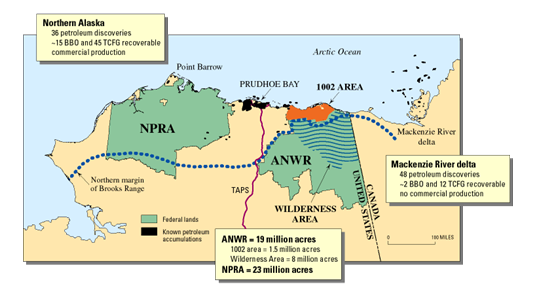Research
May 24, 2017
Trumps Budget Proposal: Energy Edition
Summary
- President Trump’s recently released 2018 budget proposal includes a host of revenue generating streams including opening the Arctic National Wildlife Refuge, placing 250 million barrels from the Strategic Petroleum Reserve on the market and discontinuing royalty payments to states along the Gulf of Mexico. Over a ten-year period, these three proposals could bring in approximately $21.9 billion.
On May 23rd, President Trump unveiled proposals for the “America First- A Budget Blueprint to Make America Great Again” which is the budget for FY18. The proposals will have a large impact on the energy community at large and will likely see a substantial amount of contention. Heavy cuts were made to the Department of Interior, down $1.5 billion or 11.7 percent, the Department of Energy down $1.7 billion or 5.6 percent, and the Environmental Protection Agency down $2.6 billion or 31.4 percent[i]. These cuts were part of a campaign promise President Trump made to curb onerous federal regulations which were severely limiting industry.
2018 Discretionary Overview by Major Agency
| Base Discretionary Funding | 2017 CR Enacted | 2018 Request | 2018 Request Less 2017 CR/Enacted Dollar | 2018 Request Less 2017 CR/Enacted Percent |
| Energy | $29.7 billion | $28.0 billion | $-1.7 billion | -5.60% |
| Interior | $13.2 billion | $11.6 billion | $-1.5 billion | -11.70% |
| EPA | $8.2 billion | $5.7billion | $$-2.6 billion | -31.40% |
The budget calls for a slough of actions which will raise federal revenues including, but not limited to:
Allowing for drilling in Alaska’s Arctic National Wildlife Refuge (ANWR).
- White House documents say opening ANWR will raise $1.8 billion in the next decade. A bill S.49, introduced in the Senate in January by Senators Murkowski and Sullivan sought to allow limited oil and natural gas development within the non-wilderness portion of ANWR, only 2,000 out of the 1.5 million acres in what is referred to as the 1002 area would be developed, this is highlighted in orange area in the map below. ANWR itself totals 19 million acres. The bill references a S. Geological Survey report that finds ANWR has an estimated 10.4 billion barrels of oil and 8.6 trillion cubic feet of natural gas, the report also finds that there is a “reasonable chance of economically producing 16 billion barrels of oil. Using today’s price of oil at $51.21, that would gross upwards of $819 billion[ii].
Source: energy.senate.gov
Placing half of the Strategic Petroleum Reserves (SPR) on the market by 2027.
- The Trump Administration says it will raise federal revenues by an estimated $16.5 billion over a 10-year span by placing 250 million barrels of reserves on the market. This estimate is based on a fixed price of $66 per barrel[iii] which is significantly higher than today’s price of oil coming in at $21[iv]. Using today’s price of oil, the revenues generated would amount to approximately $12.8 billion. The Strategic Petroleum Reserve, established in 1975 is the world’s largest stockpile of emergency crude and was created as a response to the oil embargo imposed on the United States by Arab members of the Organization of the Petroleum Exporting Countries (OPEC). The SPR acts as a U.S. Security blanket that protects us from potential oil supply disruptions or price spikes and many feel that selling half the supply is unwise, others argue that the SPR no longer serves its intended purpose and should be sold outright. According to a previous American Action Forum report, since its inception supplies from the SPR have been sold 8 times, most recently in an effort to reach a deal between the administration and Congressional leadership, the SPR sale was offered in the Bipartisan Budget Act of 2015 as part of a deal to fund the government in fiscal 2016 and 2017, and to lift the debt ceiling. The deal required 58 million barrels of oil be sold between 2018-2025. The revenue was to be deposited in the General Fund of the Treasury to “reduce the deficit.”
Discontinuing royalty payments to states along the Gulf of Mexico.
- States directly affected by this proposal include Alabama, Mississippi and Louisiana where the bulk of U.S. offshore production takes place. According to Fuelfix, those three states were estimated to receive $275 million next year in royalties, if cut this would be a major blow to their local economies. This royalty sharing concept was established under the Gulf of Mexico Energy Security Act in 2006 with the intention of increasing oil and gas leasing in the Gulf of Mexico. The Trump Administration estimates that eliminating these royalties would increase federal revenues by approximately $3.6 billion over the next 10 years[v].
Other significant proposals include:
- Restarting Licensing Activities for the Yucca Mountain nuclear waste repository. Under the Department of Energy, the proposal provides $120 million to initiate the licensing of this storage project which would directly address nuclear waste and according to the proposal, enhance national security and reduce future taxpayer burden. The budget requests provides an additional $1.4 billion increase for the National Nuclear Security Administration which is an 11 percent increase from the 2017 annualized CR level. According to a previous American Action Forum Report, resuming licensing would cut back on government nuclear waste liabilities, which will be between $29 billion and $97 billion.
- Investing over $1 billion in safe, reliable, and efficient management of water resources throughout the western United States.
- Providing $20 million for the Water Infrastructure Finance and Innovation Act program, equal to the funding provided in the 2017 annualized CR. The proposal estimates that this credit subsidy could potentially support $1 billion in direct Federal loans.
- Discontinuing funding for the Clean Power Plan, international climate change programs, climate change research and partnership programs, and related efforts[vi].
Conclusion
While budget cuts are generally not favorable, it is time that the U.S. trim the fat on some outdated and overly bureaucratic programs. In terms of energy policy, using our own natural resources to create revenue generating streams is critical from both a domestic and international security standpoint, and profits realized will allow the United States to become less dependent on foreign actors.
[i] http://thehill.com/policy/energy-environment/334619-trump-budget-slashes-epa-funding-opens-alaska-refuge-to-drilling
[ii] https://www.energy.senate.gov/public/index.cfm/2017/1/murkowski-sullivan-introduce-bill-to-allow-energy-production-in-1002-area-of-arctic-coastal-plain
[iii] https://www.politicopro.com/energy/story/2017/05/trump-budget-would-open-anwar-for-drilling-stop-oil-payments-to-gulf-states-157229
[iv] Date: May 23, 2017
[v] http://fuelfix.com/blog/2017/05/23/trump-proposes-slashing-gulf-royalty-payments-to-texas-other-states/
[vi] https://www.whitehouse.gov/sites/whitehouse.gov/files/omb/budget/fy2018/2018_blueprint.pdf











